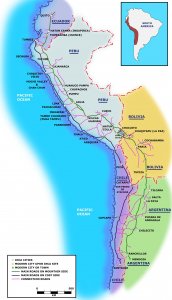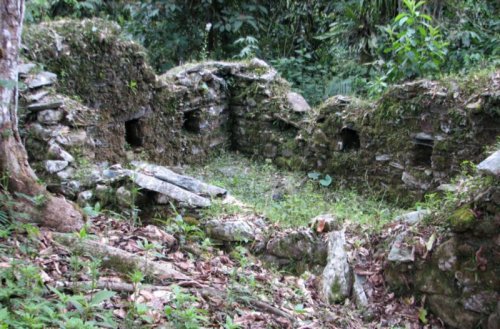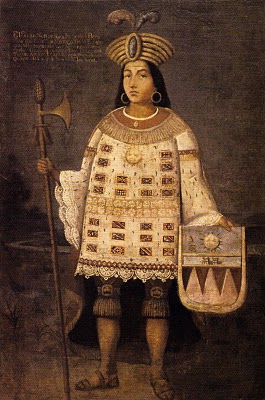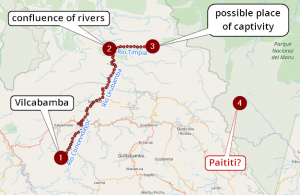
A good question with every possible bad answer. To start to deal with this problem let us imagine how the Empire of Incas was functioning before Spaniards appeared: The heart of the Empire was Cusco, the centre of everything important, the capital of Tawantinsuyu. Cusco was connected by a perfect road system with every corner of the empire. As far as we know this road system had a kind of ”supply” stations called ”tambos” every few kilometres and was served by runners bringing the news and goods from one point to another one and those “supply” stations were created in order to provide them a rest place, food and as a starting point of another runner. Thus, within a short time, a ruler of Incas’ empire had a possibility to have for breakfast a fresh fish from the Pacific Ocean or information about the economic situation of a far situated region delivered by a system of knots called Quipu—a kind of enigma system not solved until now.
What happened with Incas’ Empire after Pizarro conquered them?
As we know the new capital city was established—Vilcabamba. Here we can already ask—was it a city or a kingdom? Can we find a similar historical situation? Maybe we will propose a unique approach to this question but with similar starting points: if we look just at history of the Second World War—something that many of our relatives have still in their memory—what happened after Germany attacked the Soviet Union? Stalin—the ruler of this country had ordered to move all significant industry plants beyond the Ural Mountains. The western parts of the country were defeated by Nazis but the country on its own had its ruler and its territory.
We are aware that this is just a very simple comparison—as we know, there are no identical situations happening twice and especially not with such geographical and historical differences. Still we can say—and we can be sure about it: Vilcabamba was an independent city, it was able to provide its citizens with all basic agricultural products, and it had its ruler, so… The conclusion is that it was a kingdom in the same time too. How should we create a definition of a kingdom?
Let us say:
- It must have a king
- It must have a capital

Vilcabamba had both of them. What about Paititi? We will probably never know because there is no written history of Incas. We only can guess that Paititi did not exist anymore when the revolution of Tupac Amaru II (1780-1783) took place in Peru [1]. As far as we know, all connections with those remote places in Antisuyo were broken at this time… or is it a wrong estimation? [2] Let us see right now.
Going back again into history of the 2nd world war to catch some similarities: Czechoslovakia had an exile government in Great Britain, let us call it for our purposes ”Paititi”. That government had the support of the majority of Czechoslovakian citizens but because of the outcome of WW2 and deals between the major powers involved in WW2 this government had only a theoretical impact on the issues happening after WW2. Could Paititi have any impact on issues happening on conquered territory exposed to new laws, rules made by Pizarro etc… apart of organizing guerrilla type of attacks?
We guess not…
However, let us get again back to Peru and its tumultuous history. Having a short look at Ngrams comparing frequency of the keywords ”El Dorado” and ”Paititi” in Spanish written literature A.D.1500-2000 we have straight noticed an interesting discrepancy between the peaking points of them.
Ngrams comparison of ”El Dorado” and ”Paititi”. Source: Google Ngram Viewer
While ”El Dorado” appeared and peaked at the early stages of Spanish conquista in Peru, ”Paititi” made a similar progress much later—at the years shortly preceding the uprising of Tupac Amaru II. We do not want to try to make any connection between Tupac Amaru II and Paititi—as written above we do not expect that there was any connection anymore between the area of Paititi and the area of uprising movement. So how is it possible that “Paititi” came into daylight in such a furious way exactly at this time?
One possible explanation of this phenomenon lies perhaps hidden in the structure and organization of the Spanish colonial system in Peru. Reforms implemented by Francisco Alvarez de Toledo who became to be Viceroy of Peru in 1568 adopted certain elements of Incas’ Empire into the Spanish colonial system. Toledo divided the territory ruled by Spaniards into 614 administrative districts called repartimientos. Each repartimiento was headed by a kuraka [3].
Kurakas were privileged, free of paying taxes people, sometimes intermarried with the royal Inca descent groups [4]. They had an access to education (this was the case of Tupaq Amaru II, who was a son of a kuraka) and some of them due to intermarriages with Incas nobility maybe to some secret information too…? Let us now imagine the ordinary daily life of students in the Peru of the 18th century when the kurakas’ system was perfectly running. While chatting at a schoolyard both groups of students—those of Spanish origin and those of kurakas’ origin tried to impress each other and like this drop by drop maybe some secret information about Paititi got leaked and found its way into literature when former students became to be writers? We are aware that this is just pure speculation but for sure not an impossible one. Who knows, maybe today we would know much more about this issue if the Spaniards were not abolishing this system and not exterminating all members of Incas’ nobility and their descendants after they suppressed the uprise of Tupac Amaru II.This post is sponsored by our partners Wigs

At about the same time when Toledo started to implement his reforms the kingdom of Vilcabamba was by size and power already just a kind of tumour on the new established body of Spanish dominance in the New World, and they managed to cut off this non-malignant tumour. However, what happened after?

The inhabitants of Vilcabamba escaped before arrival of Spanish troops and they set a fire on the city. The last emperor—Tupac Amaru (1545-1572) escaped as the last one following the río Urubamba down to Amazon… Together with his pregnant wife and closest followers, they turned to the right side of the río Urubamba and we do not know their exact landing point, probable somewhere where the río Timpia meets the río Urubamba…? We can only guess… Nevertheless, that point would make sense. He could follow a path along the río Timpia, which according to Greg Deyermenjian exists today [5], until the very first shelters belonging to the area of the Inca Kingdom. It would be the only logical explanation, why he landed on the shores of the río Urubamba, knowing that Spaniards was following him. Historical records try to persuade us that Tupac Amaru was seeking a shelter by the Manaries tribe (Machiguengas today), closed allies of Incas [6]. However, we find this claim a bit troublesome. How can it explain the fact that Inca Tupac Amaru was virtually alone when Martin Garcia de Loyola and his 40 men captured him? Where were the warriors of Machiguengas (Manaries) tribe at that time, while actually some members of this tribe guided Loyola in his hunt for Inca Tupac Amaru? Did Tupac Amaru really seek a shelter by Machiguengas that at that time perhaps were not so close allies anymore or did he just want to pass their territory on his way to Paititi?
History has always its own deal with each case but seems to be very similar at least in almost all those cases of famous escapes. The escapees are usually at the point behind the ”highest point” of their wheel of destiny. They have less and less admirers while having more and more enemies. On his way to Paititi Tupac Amaru had to pass through territories of many potential new enemies—allies at the time as he had his full power and enemies when his power was over… or let us call it this way: time is changing and our preferencies (and preferences of our allies and enemies) too—c’est la vie.
References
- Tupac Amaru—Tupac Amaru II. Tupac Amaru (1545-1572) was the last Inca—the last ruler of the Kingdom of Tawantinsuyu. Tupac Amaru II (1738-1781) was a nickname of the leader of the revolution against Spaniards in the 18th century: the proper name was Jose Gabriel Condorcanqui but he took that nickname to point on his descendants of Inca origin while being the leader of the revolution against Spaniards. There is a matrilineal connection between those two Tupacs: “it is also pleasant to know that the two infant daughters of Tupac Amaru I, Juana and Magdalena, found a haven with Dr. Geronimo de Loaysa, Archbishop of Lima, until his death in 1575. Later on, Juana married the curaca of Surimani and Tungasuca (near Sicuani and not far from Cuzco), by name Condorcanqui. From her descended Jose Gabriel Condorcanqui, or Tupac Amaru II” ( The Rebellion of Tupac-Amaru II, 1780-1781. Retrieved from https://archive.org/stream/jstor-2505747/2505747#page/n7/mode/2up )
- Pointing against our expectations could be the existence of a draft of an edict that was found amongst papers of Tupac Amaru II. It is possible however, that it may have been forged by the Spaniards, in order to produce written evidence of the intentions of Tupac Amaru II. He styles himself in it as “Don Jose I, by the grace of God, Inca, King of Peru, Quito, Chile, Buenos Ayres, and the continents of the South Sea, Lord of the River of the Amazons, with dominion over Grand Paytiti” (MARKHAM, Clements R. Travels in India and Peru. London: John Murray, Albemarle Street, 1862, p. 149-150)
- Toledo Reforms, Wikipedia, last modified 11.08.2015. Retrieved from https://en.wikipedia.org/wiki/Toledo_Reforms
- Kuraka, Wikipedia, last modified 23.01.2018. Retrieved from https://en.wikipedia.org/wiki/Kuraka
- DEYERMENJIAN, Gregory. Discovery of Inca ruins at the headwaters of the Río Timpía. Athena Review, 1999. Retrieved from http://www.athenapub.com/timpia1.htm
- MACQARRIE, Kim. The Last Days of The Incas. New York: Simon & Schuster Paperbacks, 2007. ISBN 978-0-7432—6049-7, p. 371-373

